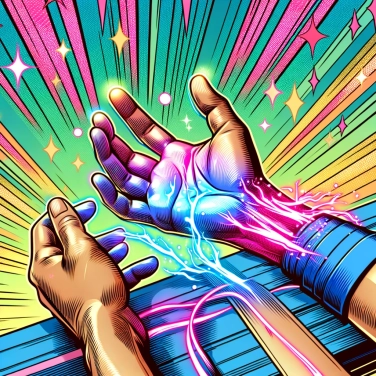After intense exercise, the body can experience an accumulation of lactic acid and a decrease in oxygen levels in the muscles, which can cause tingling in the hands and feet.

When you exert yourself intensely, your body reacts by increasing its temperature. To dissipate this excess heat, it directs more blood to your skin, especially that of your hands and feet. These areas have many small blood vessels, which dilate to facilitate heat loss. This is helpful, but it can create a strange sensation: a kind of tingling or numbness due to this sudden influx of blood to your extremities. Don't panic; it’s a natural and temporary reaction to regulate your body temperature.
During intense physical effort, your repeated or prolonged postures can create direct pressure on certain nerves. This pressure leads to a kind of numbness or tingling because the nerve signal is slowed down or disrupted. A classic example is when you hold onto a handlebar for a long time during a cycling session or when you constantly press your feet while running intensely. As a result, the compressed nerve no longer transmits sensations properly, and you then feel those little unpleasant tingles. The good news is that it's temporary: as soon as you change position or relieve the pressure on the affected nerve, the unpleasant sensation eventually goes away on its own.
When you exert intense effort, your body prioritizes the muscles that are working hard, where you need it right away. As a result, it redirects blood from less essential areas for immediate effort, like the hands or feet. This "reorganization" can temporarily decrease the amount of blood flowing to those extremities. Less blood flow means less oxygen and nutrients reaching those areas for a moment, which can give you those famous tingling sensations. As soon as you stop the effort, your body gradually restores its normal blood flow, and those sensations eventually fade away on their own.
When training intensely, you sweat a lot, and this sweat doesn't just expel water but also electrolytes, particularly sodium, potassium, and magnesium. These minerals are essential for the proper functioning of nerves and muscles. Therefore, if you lose too much water and electrolytes without compensating by drinking or snacking on something salty, your balance gets disrupted. As a result, your nerves become somewhat unsettled and can cause those unpleasant sensations of tingling or numbness in the hands and feet. Generally, it is sufficient to stay well-hydrated and replenish electrolytes to calm these sensations.
During intense exercise, your muscles are working hard and producing substances like lactic acid. When the body produces a bit too much, it accumulates in your muscles and tissues. This slight overload can irritate the local nerves and cause that strange sensation of tingling in your hands and feet after exercising. Your body eventually naturally eliminates these substances once you recover a bit, but in the meantime, it can be slightly bothersome. Don't worry, it's simply a sign that your body is working hard to remove the waste produced during intense effort.
Regularly practicing appropriate stretching and warm-up exercises before physical activity can reduce the risk of nerve compression during exertion, thereby decreasing the unpleasant sensation of tingling after exercise.
Magnesium plays a crucial role in nerve and muscle function. A magnesium deficiency can lead to the occurrence of tingling and cramps after intense physical exertion.
Some people feel tingling in their extremities when they breathe too quickly during physical exertion; this hyperventilation can temporarily reduce blood flow to the hands and feet.
The phenomenon of tingling sensations experienced after intense physical activity is medically referred to as 'transient paresthesia'. In most cases, this sensation is benign and quickly subsides after rest and rehydration.
Sure! Here’s the translation: "Yes, proper hydration before and during exercise, a gradual warm-up to promote blood circulation, and suitable clothing (avoiding tight clothes or overly fitted shoes) can help prevent or significantly reduce these uncomfortable sensations."
High-intensity exercises that heavily engage the extremities, such as running, cycling, or high-intensity weightlifting with tight grips or prolonged pressure, are the most likely to generate these sensations. Indeed, these activities often create prolonged pressure on the peripheral nerves and place significant demands on the peripheral vascular system.
In the majority of cases, the tingling sensations felt in the extremities after intense exertion are benign and related to temporary changes in blood circulation, slight nerve compression, or an electrolyte imbalance. However, if these sensations persist, worsen, or if other symptoms such as significant swelling or intense pain arise, it is advisable to consult a healthcare professional to rule out any underlying medical issues.
Not necessarily, although dehydration and electrolyte imbalance can be a common cause of tingling in the hands and feet after exercise. However, other reasons such as temporary nerve compression, poor blood circulation, or the temporary buildup of lactic acid in the muscles can also cause these sensations.
To alleviate tingling sensations after intense training, it is recommended to practice active recovery at the end of the session (light walking, gentle stretching), to stay well-hydrated to restore electrolyte balance, and to focus on a diet rich in essential minerals such as potassium and magnesium. For example, eating a banana or drinking an electrolyte beverage can be beneficial in reducing these symptoms.

0% of respondents passed this quiz completely!
Question 1/5